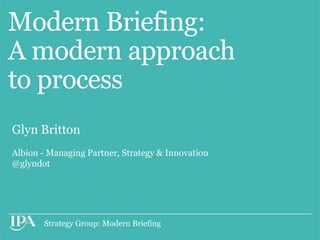Modern Process talk from IPA Modern Briefing event
- 1. Modern Briefing: A modern approach to process Glyn Britton Albion - Managing Partner, Strategy & Innovation @glyndot Strategy Group: Modern Briefing
- 2. Process? YawnĪŁ Strategy Group: Modern Briefing
- 3. WhatĪ»s the problem? Ī¬ Ī░How can I write a brief when the answer could be anything from an app to an ad?Ī▒ Ī¬ YouĪ»re trying to use Waterfall to solve business problems/opportunities. ©C Planners need to stop trying to prescribe solutions to business problems through documentation. ©C Instead be part of an Agile team iterating towards a solution. Strategy Group: Modern Briefing
- 4. Not convinced? Strategy Group: Modern Briefing
- 5. Waterfall process Ī¬ What: Prescriptive outcomes Ī¬ Who: Specialist teams Ī¬ How: Deliver handed-down scope Client Client Creative Big brief brief brief idea ----------- ----------- ----------- ----------- Client ----------- Account ----------- Planning ----------- Creative ----------- Production Role of the brief: Scope to be delivered Role of the briefing: Information sharing, handover Strategy Group: Modern Briefing
- 6. Stay with me, here comes the good stuff! Strategy Group: Modern Briefing
- 7. Agile team Ī¬ What: Solve problems Ī¬ Who: Multi-disciplined, self-organising team Ī¬ How: Iterative, collaborative process Triage Strategy Group: Modern Briefing
- 8. Agile process Ī¬ What: Solve problems Ī¬ Who: Multi-disciplined, self-organising team Ī¬ How: Iterative, collaborative process Iterate v0.3 What How ------- ------- ------- ------- Discovery Concepting Validate Role of the brief: Role of the ?briefing?: Record of task Team Knowledge gathering, and todayĪ»s solution hypothesis building, & user testing Strategy Group: Modern Briefing
- 9. Iterative approach Light 100 Pour fuel on those Fan the flames of small fires that take the largest Go / No Go decision points, with hard business metrics. Facebook Online Display Premium Media filter develop scale Strategy Group: Modern Briefing
- 10. Practical tips Ī¬ Do: Try version numbering your briefs. Ī¬ Don?t: Forget that Agile is a philosophy as well as a process. Strategy Group: Modern Briefing
- 11. Ī¬ Thank you Strategy Group: Modern Briefing
Editor's Notes
- #3: Process is an interesting word. No really.OK, I drew the short straw.To keep you entertained IĪ»ve included pictures of cute yawns throughout.But actually I do believe that process is key to resolving the modern process dilemma that Enyi set-up.
- #4: Planners are increasingly working on projects where the outcome isnĪ»t known upfront.From a world where we know the answer is going to be a TV, press, outdoor or banner ad, to a world where weĪ»re being asked to solve business problems, in a world of massive disruptive change.?We have to fundamentally change the way we try to answer these open questions.The Planner canĪ»t answer them alone and upfront. The answers canĪ»t be documented and then handed over, because the answers are complex and changing. We need a different process.
- #5: HowĪ»s it going so far?
- #6: HereĪ»s the traditional agency way of working.ItĪ»s called Waterfall, because the requirements cascade down from specialist team to specialist team.?The brief is a handover between teams. ItĪ»s an important document in a document-led process.It captures the requirements defined by Planning and hands them over to the Creative Department.?Waterfall isnĪ»t outdated, itĪ»s still really useful. ItĪ»s great, for example, for scaling big campaigns.But itĪ»s difficult for a Planner to solve alone, document and handover a very open challenge.
- #7: So whatĪ»s the alternative?Well Agile is the other main way of working.You may have heard of it before, lots written in the twittersphere.Many agencies using bits of it ©C but without adopting it wholeheartedly, it can cause chaos.Real Agile is about iterative development, where requirements and solutions evolve through collaboration between self-organizing, cross-functional teams.ItĪ»s really got two components. 1) Who does the work, and 2) How they do it.??
- #8: The way weĪ»re implementing it at Albion is to get rid of the Ī«creative departmentĪ».Instead we have a pool of T-Shaped people, each with a deep craft skill (design, writing, code, strategy, tactics, editing etc.) but also broader common interests in popular culture, technology and entrepreneurship.?When new projects coalesce, we draw talent from that pool into a project team.We do this via a triage process that predicts the Ī«idealĪ» project team, and software that finds the best match from the available talent.What weĪ»re looking for is a small team, with all the necessary skills, who like, trust and motivate each other.
- #9: That team then follow an iterative design process (explain).?Because weĪ»re not collecting all requirements at the start of the process, the client needs to be intimately involved.The planner doesnĪ»t have to do the mental wrestling alone, the process and the team can help.Agile process focuses on the teamĪ»s shared knowledge, rather than documents. The brief itself becomes very simple then:What business objective are we trying to meet?What is our current hypothesis about how to do that?
- #10: This is what an iterative approach to developing brand advertising looks.It draws on Mark EarlĪ»s idea of Ī«lighting lots of small firesĪ».WeĪ»re not making one big answer to the brief, but lots of small ones. WeĪ»re putting them all live, and seeing which perform best.ItĪ»s an objective and efficient way to work, but itĪ»s quite counter-intuitive for creative trained in the belief that theyĪ»re making art.You might think this might lead to boring, formulaic work, but itĪ»s how we created a viral video featuring Keith Harris and Orville doing an Eminem-style rap video.
- #11: OK, to finish up:Use the right process for the right job. Waterfall is still really useful.Something to try is version numbering your briefs ©C v0.1 says Ī«this is early thinking and will changeĪ». It transforms teamĪ»s understandings of the brief and briefing process, from a point in time to a process.?DonĪ»t: Forget the philosophy. Process is only part of the answer, people have to WANT to work this way.Think about how best to motivate them. We find Ī«this is how they did Old Spice Guy and Nike FuelbandĪ» works pretty well.











